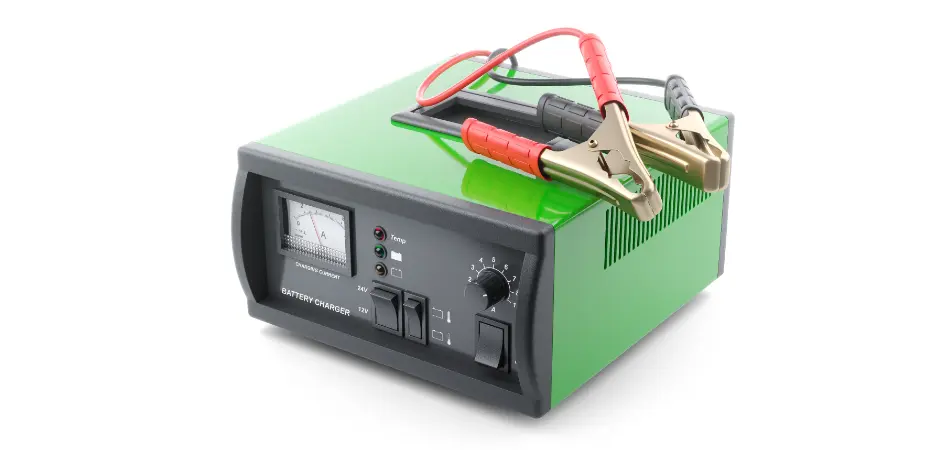How to Hook Up a Car Battery Charger: A Step-by-Step Guide

Raise your hand if you’ve ever:
- Left the car lights on overnight.
- Experienced parasitic drain (we refer to your car battery, not your digestive system).
- Left the car sitting for weeks (unlikely in California, but not impossible).
In all cases, a dead battery is the probable result. If you have a willing neighbor with a donor battery, you can jumpstart the car, but then you have to drive your car for 30 minutes or more to restore the charge.
An easier and more elegant solution is a car battery charger; if you have one handy, the more power to you — literally.
What Is a Car Battery Charger?
A car battery charger is an appliance that recharges your car’s battery using electricity from a standard power outlet. Unlike jumper cables, which temporarily boost your car battery by connecting it to another car’s battery, a charger restores the battery’s energy over time.
Battery Charger vs. Jumper Cables
Battery Charger
- Charges the battery completely, taking anywhere from a few minutes to several hours, depending on the charger type.
- Doesn’t require another car; works independently by plugging into an electrical outlet.
- Best for maintaining battery health.
Jumper Cables
- Provide a quick jolt of charge to jumpstart the vehicle.
- Require another vehicle with a functioning battery.
- Ideal for emergencies but not a long-term solution.
When Do You Need a Car Battery Charger?
Here are some situations where having a car battery charger is incredibly useful:
- Your car won’t start due to a drained battery.
- Your battery is noticeably weak and struggles to start your vehicle.
- Batteries lose charge faster in cold temperatures. You may need one if you live in Montana.
- If your car is left unused for weeks or months, a battery charger can help maintain its charge.
- Regularly using a charger to top off your battery can extend its lifespan.
How to Hook Up a Car Battery Charger
Step 1: Safety First
- Park your vehicle on a flat, level surface in a well-ventilated area.
- Turn off the car’s engine and remove the key from the ignition.
- To prevent accidents, avoid wearing loose clothing or metal accessories.
- Read your car battery charger’s user manual to familiarize yourself with its features.
Step 2: Locate the Battery
- Open your car’s hood and find the battery. (Some vehicles may have the battery in the trunk or under a protective cover.)
- Clean the battery terminals using a dry cloth or a wire brush.
Step 3: Check the Battery Voltage
- Most car batteries are 12 volts. Verify your battery’s voltage to ensure compatibility with your charger.
Step 4: Connect the Charger
- Connect the charger’s red clamp to the positive terminal of your car battery (marked with a “+” or “POS”).
- Connect the black clamp to the negative terminal (marked with a “-” or “NEG”). If instructed by your charger, attach the black clamp to an unpainted metal surface on the car’s frame to ground the connection.
Step 5: Plug in the Charger
- Plug the charger into a nearby electrical outlet.
- Ensure the charger is off before plugging it in.
Step 6: Set the Charging Mode
- Many chargers offer multiple modes, such as a “slow charge” (trickle) or “fast charge.” Select the mode based on how quickly you need the battery recharged. Slow charging is recommended for overall battery health.
Step 7: Turn on the Charger
- Switch the charger on and monitor its display (if available) to confirm it’s charging correctly.
- Most chargers notify or automatically shut off the battery upon full charge.
Step 8: Disconnect Safely
Once the battery is charged:
- Turn off the car battery charger and unplug it from the power outlet.
- Remove the black negative clamp first, followed by the red positive clamp.
Congratulations! Your battery is now charged and ready to power your vehicle.
FAQs: Car Battery Chargers
Q: How long does it take to charge a car battery?
It depends on your charger and the battery’s condition. A trickle charge may take 6–12 hours, while a fast charger can take as little as 1–3 hours.
Q: Can I use any battery charger on my car battery?
Ensure the charger’s voltage matches your battery (usually 12V for modern vehicles). Always check the user manual.
Q: How often should I charge my car battery?
Charge as needed if your battery often struggles or your car sits unused for extended periods. Maintenance chargers can keep it topped off.
Q: Can I overcharge my car battery?
Yes, overcharging can damage your battery. Use a smart charger that automatically shuts off when the battery is charged.
Q: Is it safe to charge a car battery indoors?
Only charge in well-ventilated spaces to avoid the buildup of potentially explosive gases.
Q: What type of charger should I buy?
Choose an intelligent charger with safety features like automatic shut-off and reverse polarity protection.
Q: How do I know if my battery is healthy?
Use a multimeter or battery tester to check its voltage and overall condition.
Q: Can a completely dead battery be recharged?
Yes, but it depends on the battery’s age and condition. Some batteries may no longer hold a charge if they’re too old or damaged.
More Articles

0 Comments